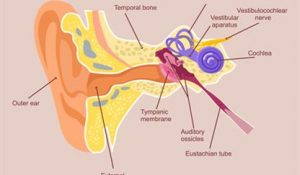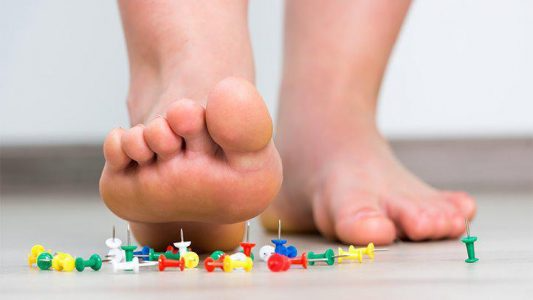Balance issues are typically caused by one or a combination of these three main causes…
Vestibular Dysfunction
Many different problems can be classified as a vestibular dysfunction but one of the most common vestibular disorders is benign paroxysmal positional vertigo, also known as BPPV. BPPV occurs when the crystals in the inner ear travel in the semicircular canals of the inner ear, where they are not supposed to be. This creates the dizzy feeling and illusion that you’re spinning with certain movements.
Another common vestibular dysfunction can happen when the reflex that keeps your eyes stable as your head turns isn’t up to par. This reflex is called your vestibulo-ocular reflex (VOR). Your VOR works with the inner ear system to help keep your balance as you’re moving around.

People who have BPPV…
- May experience symptoms including:
- Dizziness
- Nausea
- Vomiting
- Vertigo (the sense that the room is spinning)
Loss of balance or unsteadiness on your feet
May have risk factors that include:
- Being 50 years of age or older
- As we age our bone mineral density decreases which can increase the risk of the crystals in the inner ear breaking free from where they are supposed to be and traveling in the semicircular canals of the inner ear.
- Being female
- Females are more likely to develop BPPV due to an increased risk of developing osteoporosis compared to men.
- A history of BPPV
- Unfortunately, if you have a history of BPPV, there’s an increased chance of the crystals breaking free and getting into the semicircular canals again.
- A history of head trauma
- A head trauma, such as whiplash, being in a car accident, or a concussion just to name a few, can cause BPPV if the trauma was strong enough to knock those crystals loose, enabling them to find their way to the semicircular canals.
People who have an impaired VOR…
May experience symptoms including:
- Dizziness
- Nausea
- Vomiting
- Motion sickness
- Difficulty focusing or tracking objects with your eyes
- Difficulty looking at busy environments (i.e. watching traffic go by)
- Oscillopsia (vision bounces as you move)
May have risk factors that include:
- Sedentary lifestyle
- Use it or lose it (yes, the saying is true)! The less we move around the less we need to utilize our reflex to keep our vision stable.
- Head trauma
- Head trauma, such as a concussion, can impair your ability to properly coordinate eye movements and ability to stabilize your gaze.
Peripheral Neuropathy
Peripheral neuropathy can occur for a few different reasons, for example, as a result of diabetes or an autoimmune disorder, but can have a big impact on your balance and potential risk for falls when the nerves in your feet and legs are affected. Peripheral neuropathy starts at the toes and works up the legs, typically referred to as a stocking pattern. Symptoms of peripheral neuropathy typically include impaired sensation and muscle weakness which makes it increasingly difficult to keep your balance due to the decreased information your brain is getting from the nerves in your legs.

People who have peripheral neuropathy…
May experience symptoms such as:
- Numbness or pins and needles that starts in the hands or feet and spreads upwards
- Sensitivity to touch or burning sensation
- Muscle weakness or muscle paralysis
- Poor coordination and difficulty balancing
May have risk factors including (but not limited to):
- Uncontrolled diabetes
- History of alcohol abuse
- Vitamin deficiencies
- Family history of neuropathy
- Autoimmune disorders or exposure to toxins
Joint, Muscle, or Vision Problems
Joint and muscle problems can contribute to poor balance and increased fall risk. If you have shortened muscles or a joint restriction, meaning that a joint isn’t moving how it is supposed to, primarily in the low back or legs, that will limit your range of motion and could impair your balance.
Additionally, vision problems can also affect your balance and risk for falls. Most people tend to be vision dominant when it comes to their balance.

How could tight muscles or joint problems cause poor balance?
If you aren’t able to move as well as you should be able to, it will be more challenging to keep your balance and utilize your righting reaction, or your ability to catch yourself when you start to fall. When we start to lose our balance our first strategy is called our ankle strategy, meaning we use the muscles in our feet and ankles to correct our balance and we sway a little bit to keep our balance. When our ankle strategy isn’t enough then we use our hip strategy and bend at the waist to try to correct our balance. If our hip strategy isn’t enough to catch our balance then we resort to our last option, our stepping reaction where we take a step to correct our balance to stop ourselves from falling. If your joints aren’t able to move how they should, our righting reaction can be affected which makes it harder to correct our balance and keep ourselves from falling.
Why does vision play such a big role in balance?
If you find it easier to keep your balance if you stare at one single object or point in space, then you’re likely reliant on your vision to keep your balance. Your vision could be impaired for a variety of reasons including cataracts, inept eye glasses prescription, or poor lighting. If the other components of your balance aren’t up to par then it’s important to utilize your vision to its full potential to minimize the risk for falls.
Are you looking for more information and someone to tell you what is going on with your balance? Come in for a free screen with one of our therapists.
It’s a 30 minute 1-on-1 appointment with a Physical Therapist where you get the following…
1. A DIAGNOSIS: Discover the cause of your struggles so that you can attack the problem successfully.
2. A PROGNOSIS: Find out how long it will take to fix your problem for good so you can get back to all the activities you used to do.
3. A PLAN: Your Physical Therapist will lay out a clear plan that outlines what will be required to get you back to normal.
All you need to do to get started is to call (610) 839 – 8764 and pick your time and location. We look forward to meeting you and getting you back to normal!

